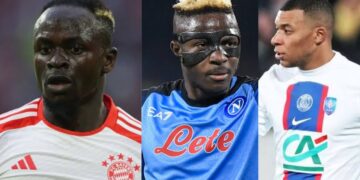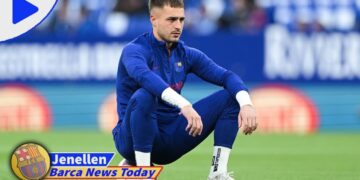They say lightning never strikes the same place twice, but when it comes to the Thunder, well, that’s different.
Led by the trio of Shai Gilgeous-Alexander, Chet Holmgren and Jalen Williams, the Thunder are well ahead of schedule on the journey to becoming legitimate contenders in the NBA. As for lightning striking twice, it’s hard not to draw parallels to where the franchise stood with the trio of Kevin Durant, James Harden and Russell Westbrook during the 2009-10 season.
Before spelling out the similarities — and differences — it’s important to acknowledge how OKC got on a fast track to the doorstep of contention. In less than five years, the franchise has found a way to shock the basketball world at all stops.
Here’s how the Thunder got here today, how they’re reminiscent of the best era in the team’s short history and what they can learn from what went wrong over a decade ago.
MORE: The funky pick-and-roll that makes Shai Gilgeous-Alexander such a headache to defend
How the Thunder got here
With one 36-foot step back from Damian Lillard, the Thunder were sent into a spiral. As the efforts of Westbrook and MVP runner-up Paul George to “run it back” proved futile, a perceived rebuild began.
First, it was a trade to send George to the Clippers in exchange for Gilgeous-Alexander, Danilo Gallinari and quite a bit of draft capital. Weeks later, the franchise decided to part ways with its heart and soul, trading Westbrook to Houston in exchange for Chris Paul and more draft capital.
As the story goes, ESPN metrics gave this iteration of OKC a 0.2% chance of making the playoffs. They demolished projections by winning 44 games in the COVID-19-impacted 2019-20 season to earn the West’s fifth seed, pushing Westbrook, Harden and the Rockets to the brink of elimination in the opening round.
The Thunder’s feel-good story ended in heartbreak, but the season itself planted the seeds for them to get here in a matter of four years.
After Gilgeous-Alexander saw playoff action in a limited role as a rookie in LA, he got a much larger taste of being the guy for a playoff team at just 22 years old. Luguentz Dort, who was 21 at the time, made a name for himself as one of the league’s premier defenders while learning the physicality of the postseason game.
The development of Gilgeous-Alexander and Dort was building block No. 1.
As for the next building block, the list of trades made and perceived “bad” contracts the Thunder took on from that point forward could get exhausting. The franchise’s approach after losing to Houston could be best described as future-focused.
The Thunder’s 46-108 record from 2020 to 2022 tells you that there wasn’t too much winning in OKC. At least on the floor. In the front office, draft capital was used to stockpile talent, with the Thunder bringing in Josh Giddey, Tre Mann, Holmgren, Williams and Jaylin Williams to build the team we know today.
Then, ahead of the 2022-23 season, something changed. Gilgeous-Alexander let it be known that the losing wouldn’t last much longer. He didn’t just say it, either, he stood on it.
History repeats itself in Oklahoma City
After declaring that the Thunder would soon become a winner, Gilgeous-Alexander blossomed into a 30-point per-game scorer, an All-Star and an All-NBA First-Team performer. With SGA as the centerpiece, the Thunder have built a dark-horse contender that features two other potential stars in the 21-year-old Holmgren and 22-year-old Williams.
Sounds familiar, right?
15 years ago, OKC was led by a 30-point per-game scorer in Durant, who was the feature piece of a cast that included 20-year-old Harden, 21-year-old Westbrook, 20-year-old Serge Ibaka and 23-year-old Jeff Green. And while the 2009-10 Thunder team burst onto the scene with 50 wins, that was only good enough for the eighth seed in an über-competitive Western Conference.
Special as the 50 wins were, the Thunder signaled their arrival by challenging the defending — and eventual — champion Lakers in the opening round of the 2010 playoffs. In 2011, OKC would reach the West Finals. In 2012, the Thunder reached the NBA Finals. Months later, failed contract negotiations with Harden resulted in a trade that signaled the beginning of the end.
Fast forward back to the present time, and everything the Thunder could hope to attain is seemingly within reach. With no bad contracts and a bevy of young talent, the Thunder are on pace to win north of 55 games and have established themselves as a threat in a Western Conference picture that can be best described as fluid.
MORE: Expert midseason award predictions: MVP, DPOY and more
The situations may not be exactly the same but the parallels between the Thunder’s first run as contenders provide a blueprint of what to do — and what not to do.
The first time around, the Thunder parted ways with Green in 2011 to make a win-now move. The acquisition of Kendrick Perkins from the Celtics played a key role in their 2012 Finals run. As our Scott Rafferty said in The Sporting News’ New Year’s power rankings, “A smart trade could set [the Thunder] up for a deep run” this season.
With some positional overlap present on the roster, a treasure trove of draft picks and a player like Davis Bertans, who, despite earning $17 million, is out of OKC’s rotation, the team can make a deal that would better prepare them for a playoff series with the West’s elite.
As for avoiding the wrong side of history, the Harden trade and its subsequent fallout is a glaring reminder to keep your top-tier talent together by any means. If the big three have been cemented as being Gilgeous-Alexander, Holmgren and Williams, pay whatever price it is that’s needed to keep them together.
Who knows, the Thunder may very well have three future MVPs on their roster. The thought alone might sound crazy now, but it’s a sentiment that certainly would have sounded crazy 14 years ago.
Learning from the past could ensure an even better future for Oklahoma City.
Read the full article here


























